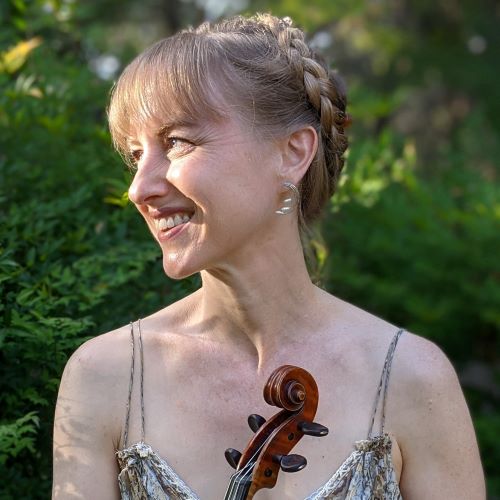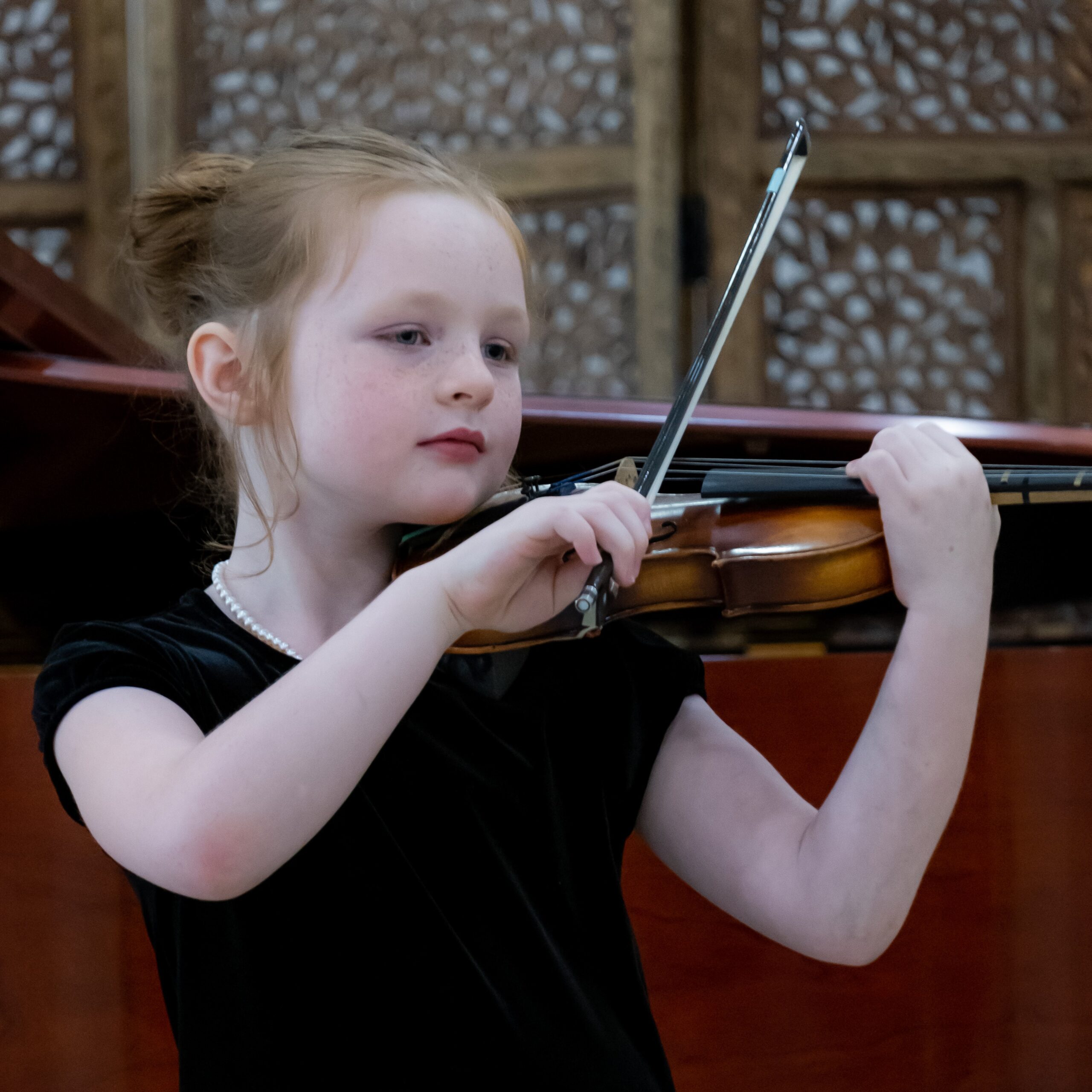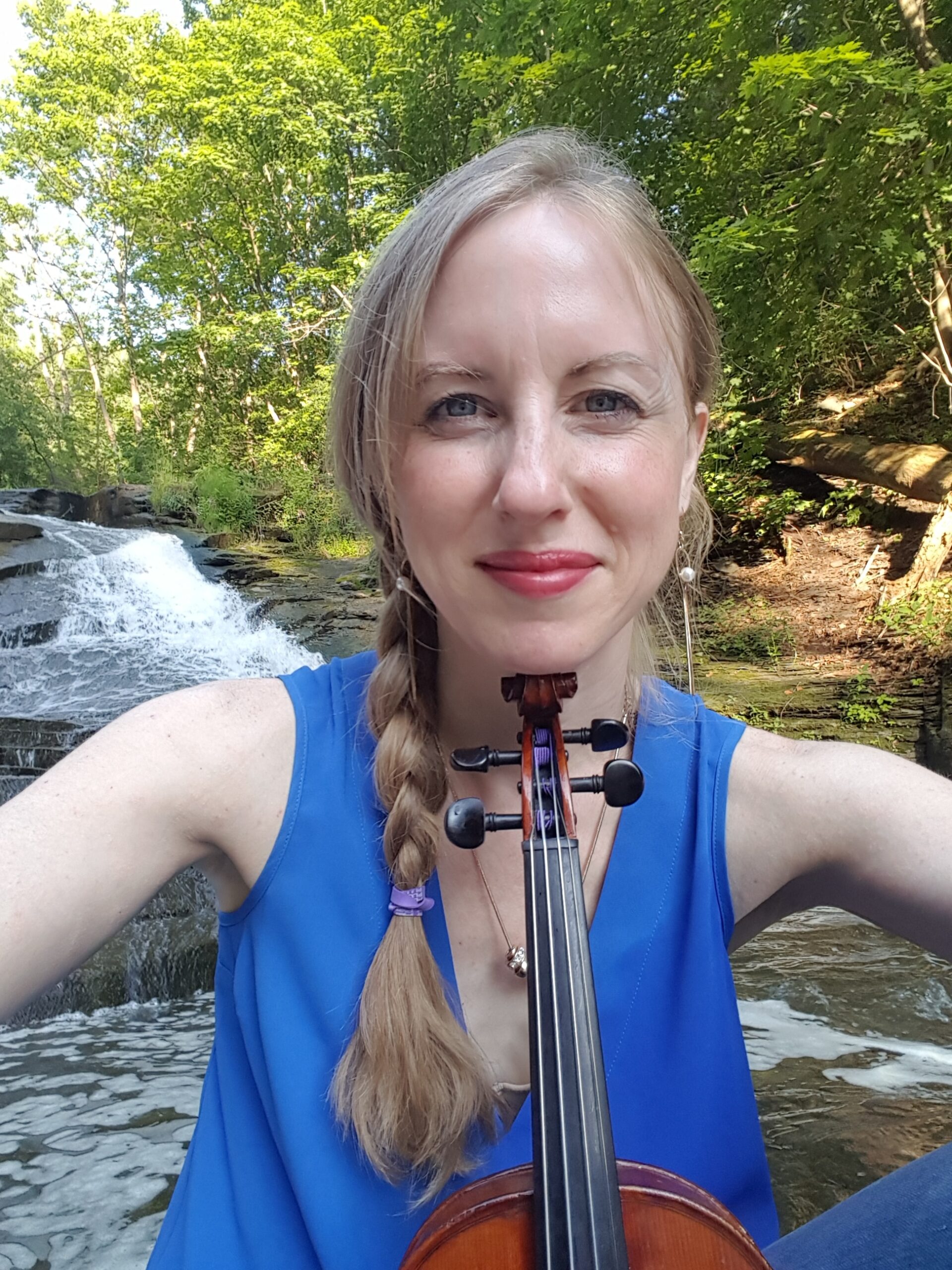Violin Book 1 Workshop:
The Balanced Violinist
Teaching movement and tonal understanding to young violinists through guided discovery
A 32-hour online course with self-paced
video content and live sessions, on the
Heartbeat platform
June 1 – August 10, 2024

Powerful tools for teaching beginners of any age
“The Balanced Violinist” is a comprehensive online teacher training with author and teacher trainer Elise Winters. The course will deepen your understanding of violin technique, approach violin playing from a more balanced and embodied perspective, and transform your approach to teaching beginners of any age.
This training is a breakthrough course integrating Montessori, Kodály and Suzuki principles into a unique and powerful violin method that allows children to experience confidence, exploration and delight throughout their first year of study.
While as teachers we strive to make the early stages of learning violin fun for our students, we often see their excitement diminish over the first year. In Kaleidoscopes, that delight increases with accomplishments all along the way.


The workshop will introduce you to a specialized sequence which is optimized to be a prequel to Suzuki Book 1. You can use this repertoire, or take the tools and apply them in your own way.
Get more information about the
Kaleidoscopes curriculum here.
A few of the tools that will build skills and excitement for your young beginners:
Ability to play a real song from the very first lesson
Even the youngest beginner can play Hot Cross Buns from the first lesson with perfect posture … on piano. Piano builds literacy and song familiarity while the teacher works on violin posture skills.
Many smaller songs instead of fewer longer ones
The goal of learning a new song makes more sense to students than “polishing” a song they already know. They love getting a new song every week. More repertoire reinforces skills and extends practice time.
Guide students to discover important insights themselves
One aspect of the Montessori philosophy is guiding students’ own discovery. This allows students to internalize concepts more deeply and build analytical ability.
Folk-song based repertoire for the first year
Singing songs before playing them trains the ear and builds fluency.
Introducing one skill at a time
Young students are not yet able to effectively focus their attention. Breaking down posture into tiny tasks accelerates learning and minimizes frustration.
Preparing left and right hand skills away from the violin
Fun, accessible movement activities are performed as “games” with each song in their repertoire. This establishes muscle memory for the skills, resulting in more stable posture with fewer corrections.
Music literacy from the beginning
Solfege, singing, and piano are used to introduce literacy during the first year. Earlier reading fluency builds musical understanding and makes advanced repertoire accessible much sooner.
Separating skills from repertoire
Students can learn “advanced” skills in tiny experiences even if their songs are not yet using these skills. These experiences build physical skill and add finesse to their playing.
Features of the Online Course

Community
Connect with colleagues going through the course with you, and stay in touch after the course ends! We use the Heartbeat community platform.

Live Sessions
Live sessions will provide opportunities to engage more deeply through conversation and coaching.
Date and times for the live sessions will include options for teachers in the Americas, Europe, and Australia / New Zealand.
Instructor Feedback
The course includes instructor feedback on homework, questions, and reflections during the active engagement portion of the course.

Accountability
Goals and incentives will help you stay on track, while keeping the timeline flexible.
What Teachers Are Saying
“I’ve been a Suzuki teacher for over 30 years. This approach has introduced a new level of musicianship into my studio. Since adding the Kaleidoscopes Book 1 at the very beginning my students have become well-rounded musicians more quickly.”
—Kay Mueller, Austin Suzuki Academy
“The training gave me confidence in starting beginners and inspired and revamped my sense of joy and creativity in lesson planning.”
—Audrey C. Lee, University of Texas
“This workshop opened my eyes to new and exciting ways of teaching music, specifically to young beginners. Elise is thoughtful, experienced, and incredibly insightful. I can’t wait to incorporate the many things I learned from her during this workshop, and would highly recommend it to all!”
– Laura Cásarez, Tucson Symphony Orchestra

The Balanced Violinist is hosted on the Heartbeat Community Platform.
Connect with other teachers and share ideas in a dedicated community of like-minded individuals. You will be able to sample the course and decide if it’s for you.
♥ As part of the sign-up process you will be asked to create a profile. You will not need to enter any payment information. Once you join, you can find the course on the left sidebar.
Course Details
Schedule
This course is asynchronous and online. Once you are enrolled, you will have access to the course and online community for two years. Lifetime access to course updates as well as the community platform is also available.
The live sessions include an introductory discussion and meet-and-greet in June, guided discovery of a bowing skill in July, and an “Ask Me Anything” session with a formal course completion in August.
Each live session will have two time options to accommodate participants in North America, Europe, and Australasia.
Content
Video Content: 32 hours of seminar videos + 12 hours of video lesson observations
In-Person Content: Three 2-hour live training sessions, beginning 4 weeks after the start of the course
Reading: You will receive a discount code to purchase the Kaleidoscopes Book 1 Teacher Guide as part of your enrollment. We suggest purchasing these as soon as possible upon enrolling, so that you can become thoroughly familiar with the content. Becoming familiar with these ahead of time will ensure that you get the most out of the course. Specific reading suggestions will accompany each lesson.
Pacing
You can complete the course on your own schedule and at your own pace! Please do note that there is a significant amount of content. We suggest staying on a routine schedule (ideally daily) to ensure that you keep your momentum. This will ensure that you meet all of the milestones and are able to attend the live sessions with your cohort.

About the Presenter
Elise Winters holds a B.A. from Rice University and a Master of Social Work from the University of Texas, with coursework in violin performance, linguistics, neurolinguistics, cognitive neuroscience, and cognition. She completed her 3-year Kodály training at Indiana University Jacobs School of Music. A former student of Ronda Cole, her Suzuki teacher trainers include Judy Bossuat-Gallic, Cathy Lee, Marilyn O’Boyle, Doris Preucil, Edward Kreitman, and Charles Krigbaum. She has extensive study in the biomechanics of violin playing following the principles articulated by dynamic movement specialists including Paul Rolland and Steve Paxton.
Elise has performed as a member of the Austin Symphony, Austin Lyric Opera, and the Grammy Award-winning Conspirare choir, and appears regularly as guest concertmistress of La Follia Austin Baroque. She is a published author with Oxford University Press and author of Kaleidoscopes for Violin, which blends Montessori and Kodaly principles within a Suzuki framework. She directs a full-time studio of 50 students in Austin, Texas.
Frequently Asked Questions
Who should take the course?
The course will be valuable to any teacher of beginners on violin or viola, regardless of repertoire. The teaching, learning, communication, and movement principles will provide valuable insights into all levels of pre-college teaching.
When is the course offered?
The course is offered once a year. You may access the course content as soon as it opens. The instructor is available for questions, feedbacks, and reviewing assignments during the 10-week summer period from June 1 – August 10.
How do the live sessions work?
The first live session is a meet-and-greet as well as a chance to talk about beginner-related topics.
The second live session is a training on Guided Discovery of a bowing pattern. Active participation in this training is required for course certification. To participate in this session, you must complete approximately 1/3 of the course — a minimum of 10 hours of video lessons plus 4 written lesson observations.
The final live session is a completion session as well as a Q&A with the instructor. To attend this session you must complete approximately 2/3 of the course — a minimum of 25 hours of video lessons plus 6 written lesson observations.
What happens if I miss a live session?
If you miss the live sessions for the course in which you are enrolled, you may join the live sessions of a future cohort, once you have completed the requirements. A small administrative fee will apply.
We strongly recommend keeping up with your assignments and completing the course with your cohort!
Can I finish the video content even if I miss a live session?
While the second live session is crucial to fully understanding certain content areas, you will have immediate access to 100% of the pre-recorded content once you enroll in the course. You can continue to work through this pre-recorded content even if you miss a live training session.
Will the class be offered in person?
The class was originally offered as a live workshop, and subsequently in a virtual live, two-week format. We have found both of these formats to be challenging, as there is quite a lot of material to absorb! We hope that the online format will allow teachers to optimize the course to their ideal pace and unique needs.
Can orchestra teachers benefit from the course?
We have had many orchestra teachers complete our training and find the tools and perspectives to be of immense value. The scaffolding of bowhold and posture skills, development of body awareness, and principles of child-centered interaction will all be applicable in a classroom situation.
Is the method available for cello?
The method has not yet been formally adapted for cello; however, the movable-do solfege can be used on any instrument. Kaleidoscopes is seeking cello teachers to help develop movement building blocks for this instrument, and a Book 1 recording for cello is planned for 2025.
While these activities are being developed, cello teachers receive a full scholarship (just pay for materials); please write Kellen at orders@discoverviolin.org to for instructions on how to register.
What are the dates for the live sessions?
All times are listed in Central (US) Time.
Meet & Greet (“Teacher Truffle”): Monday, July 1, 11 a.m. | Tuesday, July 2, 6 p.m.
Guided Discovery Training: Monday, July 15, 11 a.m. | Tuesday, July 16, 6 p.m.
Ask Me Anything (AMA) & Course Completion: Monday, August 5, 11 a.m. | Tuesday, August 12, 6 p.m.

Get immediate access to life-changing tools for working with young violinists.
One payment of $399
-or-
Four easy payments of $100
Scholarship support is available for students, recent graduates, and teachers with financial need. Please write Kellen at orders@discoverviolin.org.
